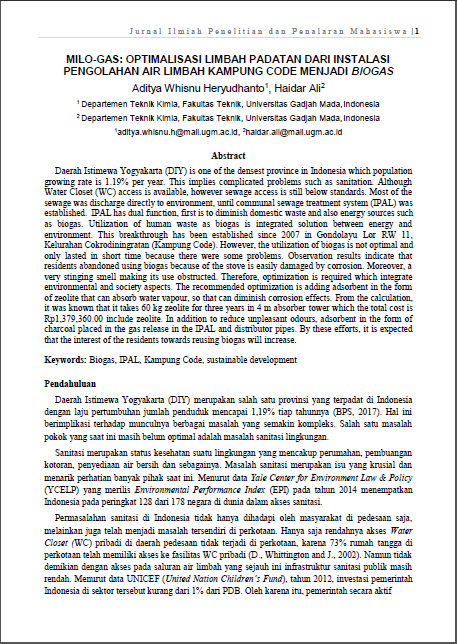MILO-GAS: OPTIMALISASI LIMBAH PADATAN DARI INSTALASI PENGOLAHAN AIR LIMBAH KAMPUNG CODE MENJADI BIOGAS
Main Article Content
Abstract
Daerah Istimewa Yogyakarta (DIY) is one of the densest province in Indonesia which population growing rate is 1.19% per year. This implies complicated problems such as sanitation. Although Water Closet (WC) access is available, however sewage access is still below standards. Most of the sewage was discharge directly to environment, until communal sewage treatment system (IPAL) was established. IPAL has dual function, first is to diminish domestic waste and also energy sources such as biogas. Utilization of human waste as biogas is integrated solution between energy and environment. This breakthrough has been established since 2007 in Gondolayu Lor RW 11, Kelurahan Cokrodiningratan (Kampung Code). However, the utilization of biogas is not optimal and only lasted in short time because there were some problems. Observation results indicate that residents abandoned using biogas because of the stove is easily damaged by corrosion. Moreover, a very stinging smell making its use obstructed. Therefore, optimization is required which integrate environmental and society aspects. The recommended optimization is adding adsorbent in the form of zeolite that can absorb water vapour, so that can diminish corrosion effects. From the calculation, it was known that it takes 60 kg zeolite for three years in 4 m absorber tower which the total cost is Rp1,379,360.00 include zeolite. In addition to reduce unpleasant odours, adsorbent in the form of charcoal placed in the gas release in the IPAL and distributor pipes. By these efforts, it is expected that the interest of the residents towards reusing biogas will increase.
Article Details
References
Badan Pusat Statistik Indonesia. (2017). Laju pertumbuhan penduduk menurut provinsi. Diambil pada 23 Maret 2017 dari https://www.bps.go.id/linkTabelStatis/view/id/1268
D., Whittington and J., B. (2002). Water and sanitation program. Wsp.Org, 16. Diambil pada 1 April 2017 dari http://www.wsp.org/wsp/sites/wsp.org/files/publications/ 426200771103_Sustainability_of_Rural_Water_Supply_Projects.pdf.
Hardjo, S., Indrasti, N. S., & Fantacut, T. (1989). Biokonversi: Pemanfaatan limbah industri pertanian. Bogor: Institut Pertanian Bogor
Horikawa, M. S., Rossi, F., Gimenes, M. L., Costa, C. M. M., & Da Silva, M. G. C. (2004). Chemical absorption of H2S for biogas purification. Brazilian Journal of Chemical Engineering, 21(3), 415–422. doi: https://doi.org/10.1590/S0104-66322004000300006.
Indartono, Y. S. (2006). Reaktor Biogas Skala Kecil/Menengah. Indonesia Energy Information Center.
Karyadi, L. (2010). Partisipasi masyarakat dalam program Instalasi Pengolahan Air Limbah (IPAL) Komunal di RT 30 RW 07 Kelurahan Warungboto, Kecamatan Umbulharjo. Kota Yogyakarta. (Skripsi). Diambil pada 3 April 2017 dari http://eprints.uny.ac.id/527/1/Lukman_K._06405244030.pdf
Marchaim, U. (2007). Biogas processes for sustainable development. Food and Agriculture Organizations of the United Nations.
Moleong, L. J. (2008). Metodologi penelitian kualitatif. Bandung: Remaja. Rosdakarya.
Nagamani, B., dan Rasamany, K. (1999). Biogas technology: An indian perspective. Current Science, 77, 44-55.
Ni'mah, L. (2014). Biogas from solid waste of tofu production and cow manure mixture : Composition effect. 1, 1–9.
Polprasert, C. (1989). Organic Waste Recycling, 2nd ed. Thailand: Environmental Engineering Div.
Asian Institute of Technology Bangkok.
Seadi, T. A., Rutz, D., Prassl, H., Köttner, M., Finsterwalder, T., Volk, S., & Janssen, R. (2008).
Biogas Handbook. Igarss 2014. doi: https://doi.org/10.1533/9780857097415.1.85
Sudjana, N., Ibrahim M. A. (2004). Penelitian dan penilaian pendidikan. Bandung: Sinar Baru Algensindo.
Sugiyono. (2010). Metode penelitian kuantitatif kualitatif dan r&d, Bandung: Alfabeta.
UNICEF. (2012). Air bersih, sanitasi & kebersihan. Ringkasan Kajian, 1–6. Diakses dari https://www.unicef.org/indonesia/id/A8_-_B_Ringkasan_Kajian_Air_Bersih.pdf.
Wahyuni M.P., Sri., (2010). Biogas. Jakarta: Penebar Swadaya.
Yale Center for Environmental Law & Policy. (2014). Environmental performance index. Diakses pada 2 April 2017 dari http://archive.epi.yale.edu/epi/issue-ranking/water-and-sanitation
Yebo Li, Stephen Y. P., Jiying Zhu. (2010). Solid-state anaerobic digestion for methane production from organic waste, 2, 822.

